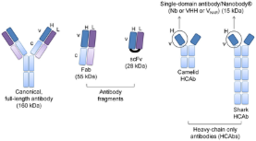Disulfide Bond-Free and Fibril-Specific Nanobodies Prevent the Prion-like Alpha-synuclein Spreading
TECHNOLOGY NUMBER: 2021-368
Tags:

OVERVIEW
A nanobody that can address brain pathology associated with Lewy body dementia- Prevents the aggregation of alpha-synuclein, the protein associated with LBD
- Single dose therapy that crosses the blood-brain barrier directly into affected cells
BACKGROUND
Lewy body dementia (LBD) is the second most common type of dementia, and it is characterized by the deposition of protein deposits in the brain called Lewy bodies that cause progressive deficits in thinking, memory, and movement. Lewy bodies are also associated with Parkinson’s Disease, and patients with LBD commonly exhibit symptoms of parkinsonism. The illness is also seen to cause neurofibrillary plaques and tangles that are common in patients with Alzheimer's dementia. LBD is chronic, debilitating, progressive, and associated with a life expectancy of 7 to 8 years following diagnosis, though progression to a fatal disease may occur much more rapidly in some of those who are afflicted with this disease. No effective treatment currently exists.
Emerging postmortem and experimental studies suggest that pathogenic alpha-synuclein (alpha-syn) is a prion-like protein driving the pathogenesis of Lewy bodies dementia (LBD). A single administration of recombinant alpha-syn preformed fibrils (PFF) in animal models can lead to substantial alpha-syn pathology spreading to the cortex, resulting in cognitive impairment. Toxic protein aggregates in the brain have been difficult to treat because antibody therapeutics cannot be efficiently delivered across the blood-brain barrier. However, antibody fragments called nanobodies offer promise thanks to their smaller size and ability to reach affected areas of the brain and parts of the toxic aggregates inaccessible to larger antibodies.
INNOVATION
Researchers have designed nanobody libraries and selected those which will preferentially bind to alpha-synuclein preformed fibrils that cause Lewy body dementia. The nanobodies are formed in a manner that excludes disulfide bonds and are therefore capable of crossing the blood-brain barrier and targeting toxic aggregates inside of the cell, where they are most detrimental, rather than outside of it. This novel therapeutic agent prevents the in vitro and in vivo aggregation of alpha-syn in the cortex of the brain where cognitive defects are created. And because the nanobody is packaged and delivered to cells in a viral vector, dementia patients may only require a single dose rather than needing to remember daily oral medications or traveling to clinics for frequent antibody infusions. More broadly, the researchers developed a library of modified nanobodies that could be interrogated against other intracellular targets that traditional antibodies have failed to address.